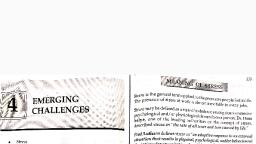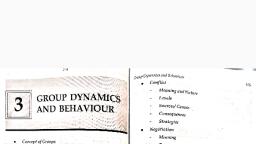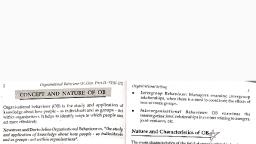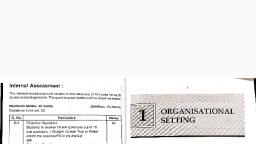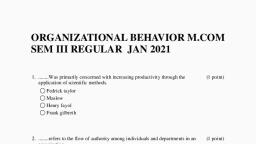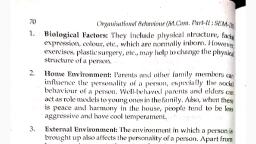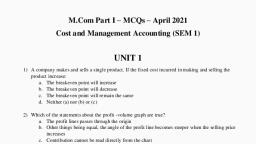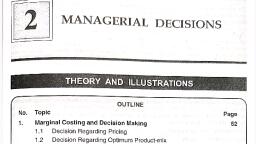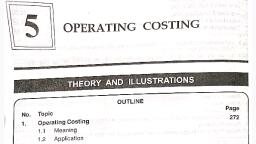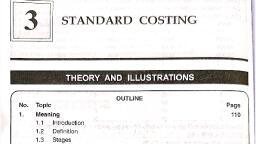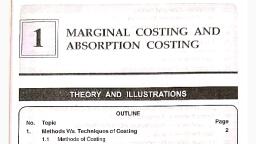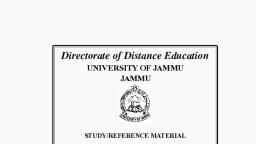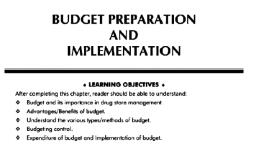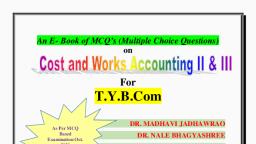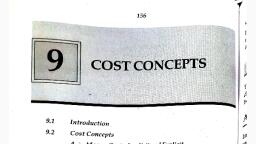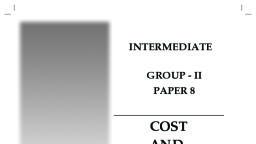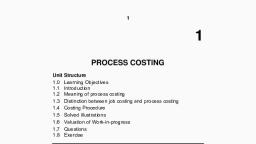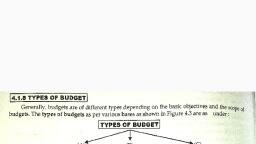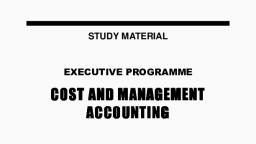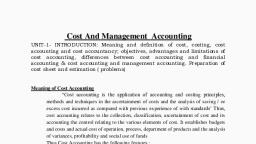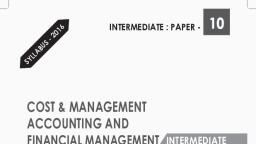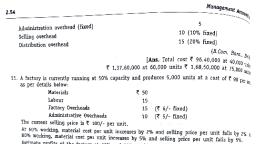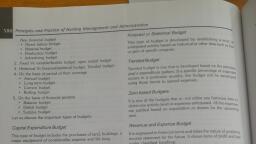Page 1 :
4 BUDGETARY CONTROL, , , , , , , , , , Sear in EMU Ui vaulncnics, , fe OUTLINE 6, , No. Topic Page, 1. Introduction 195, 2. Budget : Definition 195, 3. Types of Budgets 196, 3.1. Introduction, 3.2 Functional Budget, 3.3 Master Budget, 3.4 Fixed Budget, 3.5 Flexible Budget, 3.6 Fixed Budget V/S Flexible Budget, 3.7 Methods of Preparing Flexible Budget, 3.8 Basic Budget, 3.9 Current Budget, 4. Budgetary Control 201, 4.1 Definition, 4.2 Aspects, 4.3 Objectives, 5. Establishing a Budgetary Control System 202, 6. Administration of Budgetary Control 203, 6.1 Budget Officer or Budget Committee, 6.2 Budget Manual, 6.3 Key Factor, 7. Master Budget 205, 7.1. Definition, 7.2 Aspects, 7.3 Manner, , 7.4. Assumptions, 7.5 Purposes and Benefits, , 7.6 Limitations and Problems ae
Page 2 :
| gue 195, , , , (& Establishment of Budgets 208 B)), 9. Functional Budgets 208, 9.1 Definition, 9.2 Types, , 9.3 Forecasting V/s Budget, , 9.4 Sales Budget, , 9.5 Production Budget, , 9.6 Purchase Budget, , 9.7 Labour Budget, , 9.8 Production Cost Budget, , 9.9 Capital Expenditure Budget, , 9.10 Selling & Distribution Cost Budget, 9.11 Research and Development Cost Budget, 9.12 Cash Budget, , 9.13 Zero Based Budgeting, , 9.14 Performance Budgeting, , 10. Advantages of Budgets and Budgetary Control 218, 11. Limitations of Budgets / Budgetary Control 220, 12. Solved Problems 220, , , , 12.1 Flexible Budgets, 12.2 Cost Budgets, 12.3 Cash Budgets, 12.4 Miscellaneous Budgets J, , , , , , X, , , , 44. intRoDUeTI, , Basically, there are two main systems of cost control-Standard Costing and Budgetary Control. We, have studied in the previous Chapter how Standard Costing is useful in control of costs. Let us now, study how the technique of Budgetary control is employed to control costs., , 2. BUDGET : DEFINITION, , CIMA has defined Budget as - “A Financial and/or quantitative statement, prepared and approved, Prior to a defined period of time, of the policy to be pursued during that period for the purpose of, attaining a given objective. It may include income, expenditure and the employment of capital., , An analysis of the above definition reveals the following features ofa Budget., |. Budget is a financial and/or quantitative statement,, , 2. prepared and approved prior to a defined period of time,, , 3. of the policy to be pursued during that period,, 4. for the purpose of attaining a given objective., , Budget is thus a target fixed in terms of rupees or qu, advance. The Budget must clearly state the policies to, , antities or both. This target must be fixed in, be pursued for achieving the targets.
Page 3 :
3. TYPES OF BUDGETS, , 3.1 INTRODUCTION, , Depending upon the purpose that a Budget is expected to serve and the requirements of ip, organisation, Budgets are classified into several types on the basis of coverage, capacity and Conditions, The following chart sums up the different types of Budgets., , EXHIBIT 1) TYPES OF BUDGETS, , , , TYPES OF BUDGETS, , , , , , , , , , , , , , , , , , , , , , , , , , , , , , , , , , , , , , , , COVERAGE CAPACITY CONDITIONS, v v v, , 1. Functional, , 1. Fixed, 2. Master, , 1. Basic, 2. Flexible, , 2. Current, 3:2 FUNCTIONAL BUDGET, CIMA has defined a Functional Budget as- “4 Budget of income or expenditure appropriate to, 0, the responsibility of, a particular function.” Thus, functional Budgets pertain to the different function, or departments in an organisation such as Sales, Purchase, Production etc. Examples of Functiona, Budgets are-Sales Budget, Purchase Budget, Production Budget, Cash Budget etc. (See Para 9), , 3.3. MASTER BUDGET, , CIMA has defined a Master Budget as - “The summary Budget incorporating its component functiona, Budgets.” Master Budget is the summary of all functional Budgets described above. It contains the, summary of the Sales Budget, Purchase Budget, Production Budget, Cash Budget and so on. The, Master Budget is the basis for preparation of the Budgeted Profit and Loss Account and the Budgetec, , Balance Sheet. This budget, when finally approved by the Budget Committee, becomes the target for, the company during the budget period. It is also known as ‘Comprehensive Plan’., , Eee 4-1 elel ae, , CIMA had defined a Fixed Budget as- “4 Budget which is designed to remain unchanged irrespective, of the level of capacity or volume.” All the calculations of sales, production, expenses are related to, this specific level or volume. Fixed Budget is used as an effective tool of cost control. Such a budget, is quite suitable for fixed expenses. But, in case the level of activity usually attained is different from, the level of activity budgeted, the fixed budget becomes ineffective. It ignores the effect of change in, , volume on sales, production, expenses etc. It does not take into account the classification of costs, into fixed costs and variable costs., , 3.5. FLEXIBLE BUDGET, (1) Definition :, , CIMA has defined Flexible Budget as - “A budget which, by recognising the difference between, fixed, semi-fixed and variable costs, is designed to change in relation to the level of activity attained., AFlexible Budget does not assume a fixed level of capacity or volume. The sales, production expenses, etc. are calculated for different levels of activity. It is prepared for the level of activity usually, attained. It is more elastic, useful and practical as compared to a fixed budget. It takes into account, the effect of change in volume on sales, production, expenses etc. It may be adjusted for current, conditions arising out of seasonal changes or change in the length of working period ete. It is eae, very effective toll of cost control. It is based on the classification of costs into fixed costs an, , oe Se aaa eg ges a as
Page 4 :
5 seasonal fluctuations in 197, , ales or pro :, : ‘ duction e.g. ¢ ; ., ompany which keeps ¢ “2. cold drinks industry;, , Products or changing, , (, qyace, , 3) job4) fashion industry;, (, , on introducing new, , order industries e.g. sh ip-building;, , product design frequently;, , 5) general changes in sales,, 0 Advantages ¢, , ) Accurate Budgeting : The usi, Flexible budgeting techniques take into, the budget preparation. Since all c, consideration to volume (output) f, , © of flexible budgets helps in, , account the output f, costs do not behave in t, actor is bound to be more, , preparing more accurate budgets., , actor (various levels of activity) in, , he same manner, a budget giving, , accurate., , Pay for 7, , >) Accurate Performance Measure :T i H ‘, , 2) a juste eens Satta :T tee budgeting technique compares actual results, , gets achieved. This facilitates m i ari at, , actual and budgeted data. The vari ore meaningful comparison between, , . ances indicated by such comparis i 1, the management in cost control an ry mparison are reliable and helpful to, , d decision-making., (3) Co-ordination : Flexible budgeting technique leads to co-ordination between all activities /, , departments ofa business. Production is planned in relation to expected sales; material and, labour are acquired to meet the ex, , eeecaita pected production requirements; facilities are provided to, achieve udgetary goals and funds are made available for the necessary investments to achieve, higher output., , (4) Control d Flexible budgeting is an effective tool for management control. It helps to conduct, business operations more efficiently and to reduce losses. It helps to anal, the actual and the budgeted capacities and fixing responsibilities., , 3.6 EXHIBIT 2: FIXED BUDGET V/S FLEXIBLE BUDGET, , se cost variances between, , , , , , , , , , FIXED BUDGET FLEXIBLE BUDGET, 1. | It is designed to remain unchanged It is designed to change in relation to, irrespective of level of capacity or the level of activity attained, by, volume. recognising the difference between, fixed, semi-fixed and variable costs., 2. | It is inflexible or rigid and cannot be It is not rigid. It can be recast on the, adjusted to actual volume of activity. basis of volume of activity., 3. | All costs are related to one level of Costs are analysed by behaviour and, activity only. variable costs are allowed to be, , adjusted as per activity level attained., , , , 4. | Cost ascertainment, price fixation etc. It facilitates ascertainment of cost,, do not give a correct picture if the actual | price fixation, tendering quotations, etc., and the budgeted levels of activity differ. | at different levels of activity., , i ingful basis for, 5. i of the actual performance | It provides a meaning, raabanceiee targets will not be comparison of the actual performance, meaningful if there has been change in | with the budgeted targets., , the activity level., , ERAM ae ek dinhiain ck ee BUDGET, , F segregating costs, into fixed and variable,, : ie oleae cover methods of segregating costs, int, pethods ofiprepaning Hleeble Pe ble costs into their fixed and variable components., , , , , , , , , , , , , , 'ncluding methods for segregating semi-varla, , Semi-variable Costs, , “ st which i rtly fix tly, , (1) Meaning : Semi-fixed or Semi-variables Cost means 4 cost which air ae ary an, variable” (CIMA-England). These costs are fixed at a particular | carentar evel of output and, at cther level of output. Telephone expenses, coasts are fixed at a pa
Page 5 :
198 Cost and Management Accounting (M.Com. Part-I: Sky. y, , tend to very at other levels of output. Telephone expenses, remuneration of supervisors are some, , examples or semi-fixed or semi-variable costs. These are a sort of mixed or hybrid costs - Partly, , fixed and partly variable. No costs are truly fixed or truly variable. We have seen that under, certain circumstances, both fixed and variable costs change their basic characteristics, Some, items of variable overhead contain a fixed clement and similarly, a part of the fixed overheaq, tends to very with output levels., , (2) Types : Semi-variable costs may be classified under four basis types :, , (i) Partly Variable, Partly Fixed Costs : Expenses which possess the characteristics of both, fixed and variable costs and cannot, therefore, be placed straightaway in either category, Examples of such partly variable and partly fixed expenses are indirect labour, maintenance, and repair expenses, general stores, and power cost., , (ii) Stepped Costs : The relationship between the semi-variable cost and volume is neither linear, nor curvilinear but takes the form of steps, i.e. when there are major changes in the volume of, output, the costs may jump in steps. For example, an increase in volume may lead to an, increase in the strength of the supervisory staff or the working of an additional shift., , (iii) Seasonal Costs : Certain costs of a semi-variable nature tend to be higher or lower during, specific period for reasons not related to volume, e.g. cost of heating, air-conditioning, and, lighting may be seasonal (lighting cost may be higher during the winter months) or machine, maintenance and repairs may be undertaken only during certain periods according to, convenience., , (iv)Disproportionate Costs : Costs become semi-variable when, with increases in volume, they, increase at an accelerated or retarded rate. This happens particularly when the maximum, operating capacity is reached or exceeded; further increase in cost is not proportionate to the, increase in volume., , (3) Segregation : Semi-variable overheats are made of two elements - a fixed element anda variable, element. The two elements need to be separated (segregated) first. Then, the fixed element is, added to Fixed Costs and the variable element is added to the Variable Costs. Basically, the, method of analysis and separation of fixed and variable costs consists in finding out first, the, amount of fixed cost in an item of expenditure and then determining its variability with output., There are several methods available for the purpose, a few of which are discussed below., , Gi) Method of Simultaneous Equations : The equations for relating costs to volume is, y = mx + c, where y, = total cost, m = variable cost per unit of output, x = volume of output, and c= fixed cost. For the purpose of separating fixed and variable expenses, the expenditure, against an item is determined at various levels of output and pairs of values of x and y are, fitted in the above formula in order to compute the values of m and c . The simultaneous, equations method affords a simple and easy means of separating fixed and variable overhead, costs, but it has the following /imitations :, , (a) It assumesa liner relationship between output and variable overhead costs, viz, that, for each unit of output the same amount of variable overhead cost is incurred. In, practice, this my not be so., , (b) Different result are obtained by talking different sets of data for volume and overhead, cost. It cannot be definitely said that the particular data selected will give the most, accurate result., , Gii) High and Low or Range Method : High and Low Method also known as Range Method is, similar to the method of simultaneous equations. The di fference between the highest and, lowest volumes over a particular range and the difference of the corresponding costs are, worked out and the variable and fixed costs are separated. In addition to the limitations of the, method of simultaneous equations discussed above, the high and low points method has the |, following drawbacks : |, , (a) Ifthe high or low points are at the extreme, the results obtained are not likely t0 |, accurate., , (b) Ifhigh or low levels of activities occur for very short periods only, the corresponding

